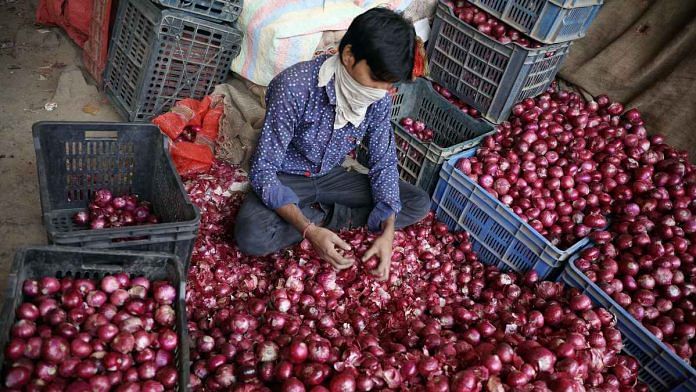New Delhi: Onion prices rise almost every year in the lean supply season between September and November, and that’s why the central government last year decided to double the buffer stock of the commodity to 2 lakh metric tonnes (LMT). But the government agencies in charge of procurement have fallen short of their initial target due to Covid-induced lockdowns in major onion-producing states, which means prices are likely to rise again this year.
Central agencies have so far managed to procure only 1,570 metric tonnes of onion as on 15 May, against the initial target of 10,000 metric tonnes. This means that the government won’t have enough buffer stock to intervene in the market and cool down prices, amid supply shortages and disruption.
Onion prices at wholesale mandis in major centres of consumption have already started surging, due to supply disruptions caused by the differing lockdowns in states that produce the commodity.
Also read: Poor storage, panic imports, govt failures led to 2019 onion crisis. It could happen again
Why buffer stocks are needed
Government agencies such as the National Agricultural Cooperative Marketing Federation of India (NAFED) procure onions for buffer stock from farmers mostly in the major onion-producing states of Maharashtra, Gujarat, Rajasthan and Madhya Pradesh.
Apart from stabilising prices when necessary, buffer stocks are also used if there’s a shortage of onions due to crop failure or bad weather. These stocks also provide farmers with better pay if a lack of demand causes a fall in prices. However, over the last two years, onion prices have touched Rs 100 per kg as a large quantity of buffer stocks was destroyed due to high moisture content.
A senior consumer affairs official, who wished to remain anonymous, said: “With the initial slowdown in procurement pace, the estimated buffer stock of onion has now been decreased to 1.25-1.5 lakh metric tonnes. The procurement process was slow since its start in the third week of April, but has further slowed down in recent weeks with increasing cases and lockdown measures in major markets.”
The official explained: “Monsoon rains are approaching, and along with the current cyclone Tauktae in the Arabian Sea, are likely to increase the moisture content in onions, which could lead to an early decay and cause inflation again in the lean season around Diwali. The rains make onions unfavourable for procurement and storage, because if they deteriorate rapidly, they are useless for distributing in the market to ease prices.”
Covid lockdowns hit procurement
A majority of the onion procured for the buffer stock is what is harvested in the ongoing rabi season, as it has lower moisture content than the produce from the kharif season.
However, in the major onion-producing states of Maharashtra, Gujarat, Madhya Pradesh and Rajasthan, the massive Covid-19 caseload and death figures have led to stringent lockdowns. Officials in these states involved in the procurement of onions say fewer farmers are turning up for procurement owing to transport-related restrictions.
In Maharashtra, the state cabinet Wednesday agreed to extend the lockdown and other restrictions till 1 June, with anyone entering the state needing to carry a negative RT-PCR test report. In Madhya Pradesh, there are lockdowns of varying degrees in different areas — in Bhopal, the shutdown has been extended till 24 May, while in Gwalior and Morena, the new date is 30 May.
Rajasthan is under a strict 15-day lockdown till 24 May, with markets, religious places and vehicular traffic shut, and wedding ceremonies banned. In Gujarat, meanwhile, many cities have been put under night curfew and other movement restricted till 18 May.
Nana Saheb Patil, NAFED’s director in Maharashtra, told ThePrint: “The second wave of Covid-19 might have an adverse impact on onion procurement. Even Lasalgaon Mandi in Nashik, which is Asia’s largest onion mandi, is closed for 10 days till 23 May. The lockdown has caused major labour shortage and closure of markets, hitting the pace of procurement of onion harvested in April-May, which is to be stored in buffer stock.”
Patil added that the agencies are still making arrangements to try and speed up the procurement process.
“Various employees of mandi committees such as traders and commission agents have been assigned areas, and farmers can reach out to them for facilitating doorstep procurement. After the monsoon strikes, the quality of onion will degrade, which will make it unsuitable for procurement and storage,” he said.
According to the Ministry of Health and Family Welfare website, as on 17 May, Maharashtra had 4,70,595 active Covid cases, while Rajasthan had 1,94,382, Gujarat 1,04,908 and MP 94,652.
Prices already surging
In Delhi’s Azadpur Mandi, the arrival of onion has fallen in the space of a week to 368 tonnes on 14 May from 714 tonnes on 7 May. In the same period, according to data from the Ministry of Food and Consumer Affairs, the price of onion has soared to Rs 1,350 per quintal from Rs 850 per quintal.
In Bihar’s capital Patna, wholesale prices have increased to Rs 1,900 per quintal on 14 May from Rs 1,500 per quintal on 14 April. The percentage growth for retail prices has, as a result, seen double-digit growth.
(Edited by Shreyas Sharma)
Also read: Chicken or egg? Doesn’t matter, neither is really selling well since Covid hit India



